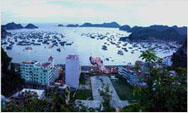On November 10, 2002, President Hamid Karzai oversaw the groundbreaking of Afghanistan’s main highway from Kabul through Kandahar. President Karzai stated that reconstruction of the country’s principal road system is the key to Afghanistan’s economic recovery. A year later, USAID completed the rebuilding of Afghanistan's national road system (also known as the "Ring Road") which links its two largest cities and economic centers.
With the opening of this major route from Kabul through Kandahar in 2003, USAID’s construction has reduced travel times from two days to approximately five hours with travel speeds increasing to an average 60 mph. A little more than a year ago, this road was a broken strip -- mined, bombed, and pockmarked by neglect. USAID support to Afghanistan in the last two years has totaled more than $1.7 billion dollars - approximately $190 million was spent on the Kabul to Kandahar highway segment. The entire length of the Kabul-Kandahar highway is 300 miles with USAID responsible for completing 242 miles of the highway.
This improvement has also increased economic opportunities for Afghans living in proximity to the road, and has accelerated de-mining efforts allowing safe passage within this heavily traveled transportation corridor. Of the 20.6 million Afghans, 13.6 million or 66% live within 50km of Ring Road. More than 1,060 mines and unexploded ordnances were removed by de-miners prior to construction which now allows safe pedestrian and horse drawn traffic to travel on the road shoulders.
| 

